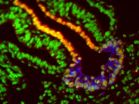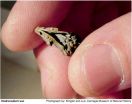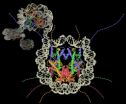(Press-News.org) PHILADELPHIA – Discovering the step-by-step details of the path embryonic cells take to develop into their final tissue type is the clinical goal of many stem cell biologists.
To that end, Kenneth S. Zaret, PhD, professor of Cell and Developmental Biology at the Perelman School of Medicine at the University of Pennsylvania, and associate director of the Penn Institute for Regenerative Medicine, and Cheng-Ran Xu, PhD, a postdoctoral researcher in the Zaret laboratory, looked at immature cells called progenitors and found a way to potentially predict their fate. They base this on how the protein spools around which DNA winds -- called histones -- are marked by other proteins. This study appeared this week in Science.
In the past, researchers grew progenitor cells and waited to see what they differentiated into. Now, they aim to use this marker system, outside of a cell's DNA and genes, to predict the eventual fate. This extra-DNA system of gene expression control is called epigenetics.
"We were surprised that there's a difference in the epigenetic marks in the process for liver versus pancreas before the cell-fate 'decision' is made." says Zaret. "This suggests that we could manipulate the marks to influence fate or look at marks to better guess the fate of cells early in the differentiation process."
"How cells become committed to particular fates is a fundamental question in developmental biology," said Susan Haynes, PhD, program director in the Division of Genetics and Developmental Biology at the National Institutes of Health, which funds this line of research. "This work provides important new insights into the early steps of this process and suggests new approaches for controlling stem-cell fate in regenerative medicine therapies."
A Guiding Path
How the developing embryo starts to apportion different functions to different cell types is a key question for developmental biology and regenerative medicine. Guidance along the correct path is provided by regulatory proteins that attach to chromosomes, marking part of the genome to be turned on or off. But first the two meters of tightly coiled DNA inside the nucleus of every cell must be loosened a bit. Regulatory proteins help with this, exposing a small domain near the target gene.
Chemical signals from neighboring cells in the embryo tell early progenitor cells to activate genes encoding proteins. These, in turn, guide the cells to become liver or pancreas cells, in the case of Zaret's work. Over several years, his lab has unveiled a network of the common signals in the mouse embryo that govern development of these specific cell types.
Zaret likens the complexity of this system to the 26-letter alphabet being able to encode Shakespeare or a menu at a restaurant. Many investigators are now trying to broadly reprogram cells into desired cell fates for potential therapeutic uses.
The researchers had previously shown that a particular growth factor that attaches to the cell surface, gives a specific chemical signal for cell-type fate, promoting development along the liver-cell path and suppressing development along the pancreas-cell path. Liver and pancreas cells originate from a common progenitor cell type.
Zaret's group figured out which enzymes -- called histone acetyl transferases or methyl transferases (that add methyl groups or acetyl groups to histones) are relevant to the pancreas arm of the liver-pancreas fate decision. They used mice in which they knocked out the function for one enzyme type versus the other to induce the development of fewer liver cells and more pancreas cells.
The transferases mark genes for liver and pancreas fates differently before a cell moves into the next intermediate type along the way to becoming a mature liver or pancreas cell.
Investigators want to make embryonic stem cells for liver or pancreatic beta cells for therapies and research. To do this, they mimic the embryonic developmental steps to proceed from an embryonic stem cell to a mature cell, but have no way of knowing if they are on the right track. The hope is that the findings from this study can be applied to assess the epigenetic state of intermediate progenitor cells.
"By better understanding how a cell is normally programmed we will eventually be able to properly reprogram other cells," notes Zaret. In the near term, the team also aims to generate liver and pancreas cells for research and to screen drugs that repair defects or facilitate cell growth.
With regenerated cells, researchers hope to one day fill the acute shortage in pancreatic and liver tissue available for transplantation in cases of type I diabetes and acute liver failure.
INFORMATION:
The research was funded by the Institute of General Medical Sciences and the Institutes for Diabetes, Digestive, and Kidney Disorders.
Penn Medicine is one of the world's leading academic medical centers, dedicated to the related missions of medical education, biomedical research, and excellence in patient care. Penn Medicine consists of the Raymond and Ruth Perelman School of Medicine at the University of Pennsylvania (founded in 1765 as the nation's first medical school) and the University of Pennsylvania Health System, which together form a $4 billion enterprise.
Penn's Perelman School of Medicine is currently ranked #2 in U.S. News & World Report's survey of research-oriented medical schools and among the top 10 schools for primary care. The School is consistently among the nation's top recipients of funding from the National Institutes of Health, with $507.6 million awarded in the 2010 fiscal year.
The University of Pennsylvania Health System's patient care facilities include: The Hospital of the University of Pennsylvania -- recognized as one of the nation's top 10 hospitals by U.S. News & World Report; Penn Presbyterian Medical Center; and Pennsylvania Hospital – the nation's first hospital, founded in 1751. Penn Medicine also includes additional patient care facilities and services throughout the Philadelphia region.
Penn Medicine is committed to improving lives and health through a variety of community-based programs and activities. In fiscal year 2010, Penn Medicine provided $788 million to benefit our community.
Predicting the fate of personalized cells next step toward new therapies
2011-05-20
ELSE PRESS RELEASES FROM THIS DATE:
Large brains in mammals first evolved for better sense of smell
2011-05-20
Pittsburgh, Pennsylvania… Paleontologists have often wondered why mammals—including humans—evolved to have larger brains than other animals. A team of paleontologists now believe that large brains may have developed in mammals to facilitate an acute sense of smell, according to a new paper published today in the prestigious journal Science. The team also noticed enlargement in the areas of the brain that correspond to the ability to sense touch through fur; this sense is acutely developed in mammals.
Scientists used high-resolution CT scans to study rare 190-million-year-old ...
Death of Osama bin Laden Highlights Importance of the Zadroga Act, Says New York Personal Injury Lawyer
2011-05-20
After the death of Osama bin Laden, New York personal injury lawyer David Perecman reaffirmed his commitment to help the heroes who are still battling illnesses connected to 9/11.
For many individuals, the death of bin Laden brought closure. The death also served to rekindle memories of those who volunteered to assist at the World Trade Center site after the 9/11 attacks.
The lives of many Ground Zero volunteers were changed in challenging ways. Rescue and recovery workers and others are still suffering from health consequences related to the World Trade Center disaster.
"People ...
Scientists discover new drug target for squamous cell carcinoma
2011-05-20
SEATTLE – Researchers at Fred Hutchinson Cancer Research Center have discovered a new drug target for squamous cell carcinoma – the second most common form of skin cancer. Scientists in the laboratory of Valeri Vasioukhin, Ph.D., have found that a protein called alpha-catenin acts as a tumor suppressor and they also have unlocked the mechanism by which this protein controls cell proliferation.
The findings by Vasioukhin and colleagues will be published May 24 in Science Signaling.
For the study, the researchers studied mice that were bred to lack a copy of the gene that ...
Packaging process for genes discovered in new research
2011-05-20
Scientists at Penn State University have achieved a major milestone in the attempt to assemble, in a test tube, entire chromosomes from their component parts. The achievement reveals the process a cell uses to package the basic building blocks of an organism's entire genetic code -- its genome. The evidence provided by early research with the new procedure overturns three previous theories of the genome-packaging process and opens the door to a new era of genome-wide biochemistry research. A paper describing the team's achievement will be published in the journal Science ...
Senators Want DUI Applications Removed From Smartphones
2011-05-20
In March, four Democratic U.S. Senators, Harry Reid, D-Utah, Chuck Schumer, D-N.Y., Frank Lautenberg, D-N.J., and Tom Udall, D-N.M., drafted a letter requesting that Apple, Google and Research in Motion (or RIM) eliminate the applications (user-friendly computer programs for specific tasks) on mobile communication devices that warn drivers of the locations of drunk-driving checkpoints.
The next day, RIM, the manufacturer of the BlackBerry agreed to the removal of driving-under-the-influence (DUI/DWI) checkpoint functionality on its BlackBerry devices.
Google later ...
What Causes the Metal Skin on an Airliner to Tear Apart?
2011-05-20
On Friday, April 1, 2011, a Southwest Airlines Boeing 737-300 experienced a rapid decompression when the metal fuselage skin tore apart, leaving a 5X1 foot hole. This kind of event is rare, but can, and has been, catastrophic when it does occur.
In 1988, another Boeing 737, a 200 model, experienced a similar, but much worse, event over Hawaii. In that case, the skin on the entire front section of the aircraft cabin was denuded, leaving the passengers sitting in the first several rows completely exposed, with the aircraft being held together by two metal spars running ...
Of frogs, chickens and people
2011-05-20
Researchers at the University of California, San Diego School of Medicine have uncovered new details of an unusual biological mechanism in the brains of diverse species that not only helps regulate how their brains develop, but also how they function later in life. The discovery could lead to new biomarkers for specific neurological diseases in humans and, possibly, the development of drugs to cure them.
The research, by Miles F. Wilkinson, PhD, professor of reproductive medicine and a member of the UCSD Institute for Genomic Medicine, and colleagues, is published in ...
Preparing for a Prenuptial Agreement
2011-05-20
Thinking about, let alone preparing for, divorce before you are even married is not what most of us want to do. Whether we believe that divorce will never happen to us or whether we just choose to ignore the possibility, the fact remains that almost half of all marriages in the United States end in divorce.
One way to enter into a marriage prepared for all outcomes is to create a prenuptial agreement. Creating this agreement doesn't mean that your marriage will eventually come to an end. Rather, creating a prenuptial agreement is just a way for you and your spouse to ...
Looking deep into a huge storm on Saturn
2011-05-20
The atmosphere of the planet Saturn normally appears placid and calm. But about once per Saturn year (about thirty Earth years), as spring comes to the northern hemisphere of the giant planet, something stirs deep below the clouds that leads to a dramatic planet-wide disturbance (eso9014 - http://www.eso.org/public/news/eso9014/).
The latest such storm was first detected by the radio and plasma wave science instrument on NASA's Cassini spacecraft [1], in orbit around the planet, and also tracked by amateur astronomers in December 2010. It has now been studied in detail ...
Supreme Court Seems to Give Prosecutors Free Pass to Win at All Costs
2011-05-20
A recent opinion from the U.S. Supreme Court in Connick v. Thompson seems to give prosecutors a free pass to win at all costs. The opinion overlooks a pattern of misconduct by prosecutors in cases against John Thompson, who was almost executed before he was exonerated and set free. Thompson's experience demonstrates the need for capable legal counsel to fight against any prosecutorial misconduct when facing criminal charges.
Connick v. Thompson
In 1984, John Thompson was convicted of armed robbery in Louisiana. In 1985, Thompson was also tried and found guilty of ...




